GPAnalysis Individual Comic Volumes and the CGC Census
The GPA Top Individual Comic Volume Reports << https://comics.gpanalysis.com/market-reports/frequency-of-trade/gpa-top-individual-comic-volume-report-regardless-of-grade-progressive-monthly >> are included in the GPAnalysis.com Market Reports providing monthly and progressive lists. The progressive list displays the most frequently sold individual comics for the prior twelve months, regardless of the CGC grade or notes (universal, restoration, etc.).
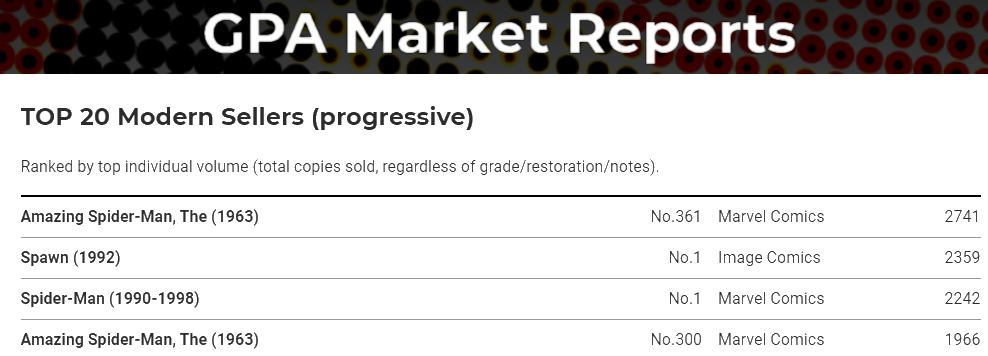
Combining the sales volume reports with the CGC Census may provide insight about market trends or shifts by percentage, and not just by sales counts. For example, Amazing Spider-Man #300 is the most submitted comic book to CGC, having the highest CGC Census count with 27,021 graded copies. It is not surprising to see Amazing Spider-Man #300 on the GPA Top Individual Comic Volume Report, since more CGC graded copies exist for this comic than any other. For the prior twelve months from November 2020 to October 2021, Amazing Spider-Man #300 was the 4th most often sold individual comic book in the Modern category and overall, with 1,966 recorded sales. These 1,966 recorded sales represent 7.3% of the 27,021 graded copies on the CGC Census. How does this 7.3% in the prior twelve months compare with the other comics on the GPA report? Amazing Spider-Man #300 isn’t at the top by percentage.
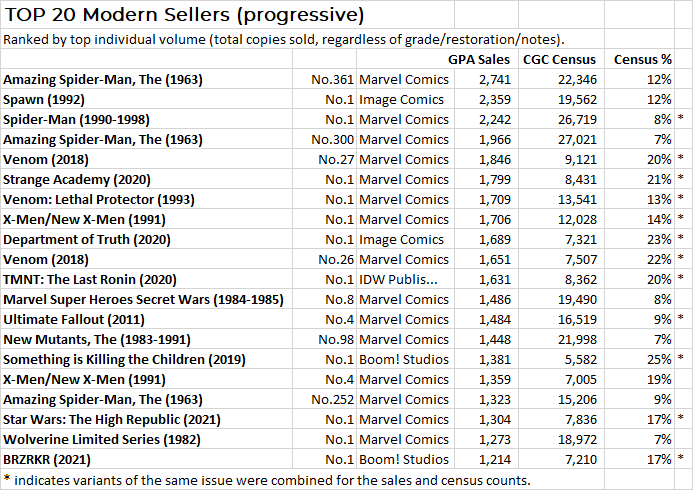
Viewing the Top 20 Modern Sellers (progressive) in terms of the CGC Census percentage allows the number of sales to be balanced against the CGC Census, revealing which individual comics from the Top 20 were traded at the highest percentage of the CGC Census. Among the Top 20 Modern Sellers, Something Is Killing The Children #1 (2019) and Department of Truth (2020) #1 have the highest percentage. This is not surprising because both comics were printed quite recently, and the all-time market activity is confined to the short period of time since the comics were printed. Sorting the Top 20 Modern Sellers by the CGC Census %, the most recently-printed issues do dominate the top of the list, however, X-Men #4 (1992) had 19% of the total CGC Census change hands in the prior twelve months, higher than both BRZRKR #1 (2021) and Star Wars: The High Republic #1 (2021)
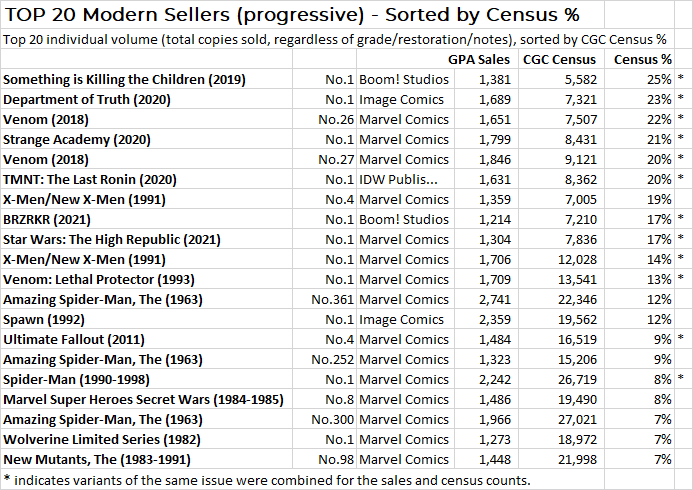
When sorted by the newly-calculated CGC Census %, the most-submitted comic of all time, Amazing Spider-Man #300 drops to the bottom of the Top 20 Modern, indicating that the prior twelve months of GPA recorded sales are not unusually high percentage-wise, despite the volume of sales recorded. Amazing Spider-Man #361 (1992) has a 12% Census % for the prior twelve months, reflecting the increased market activity coinciding with the 2021 Venom 2 movie, debuting the live-action Carnage character first featured on the ASM #361 cover in 1992. Venom: Lethal Protector #1 (1993) has a Census % of 13% also coinciding with the Venom 2 movie advertisements and release.
By applying the CGC Census counts and calculated Census % to the GPA Top 20 individual comic volume lists for older comics, the recently-printed issues will be excluded. Time-specific trends related to the external influences of movie production, streaming series, and box office releases should be discernable among the comics which are simply sold most often because they are graded most often.
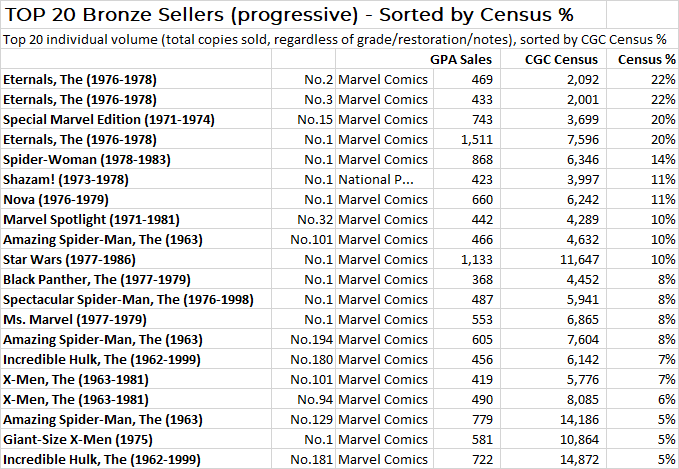
The Top 20 Bronze Sellers (progressive) is dominated in Census % by Eternals (1976) and Special Marvel Edition #15 (1973) at 20% to 22%, reflecting the popularity of the Eternals and Shang Chi movie releases at a higher percentage than that of Venom and Carnage at 13% and 12% in the Modern category. The CGC Census for Venom: Lethal Protector #1 and Amazing Spider-Man #361 is much higher than issues of Eternals and Special Marvel Edition, and the corresponding percentage of sales in the prior twelve months is lower.
The CGC Census reflects just over 20 years of CGC grading, so it would be expected that a 5% sales percentage in 2020-2021 would reflect one-twentieth of that CGC Census. Attention is often given to Incredible Hulk #181 in the Bronze Age marketplace, however, the Census % for the prior twelve months is only 5%, indicating that market activity for the book is not significantly greater than in prior years or unexpected for a twelve-month period of sales activity. Likewise, Amazing Spider-Man #129 and Giant-Size X-Men #1 also reflect 5% for the prior twelve months.
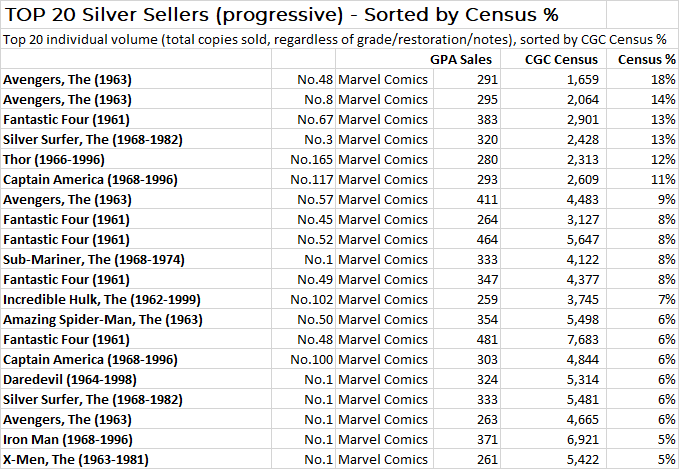
None of the Top 20 Silver Sellers reflect a CGC Census % of 20% or higher. All of the Top 20 Silver CGC Census % of at least 10% coincide with Marvel cinematic or streaming productions. Avengers #48 features the Black Knight, included (however briefly) in the Eternal movie. Avengers #8 is the first appearance of Kang, featured in the Loki streaming series. These top two by Census % feature characters which have made their live-action debuts in 2021 Marvel productions. The next three comics are associated with planned or rumored live-action Marvel characters, Fantastic Four #67 and Thor #165 are best known for their connection to Him / Adam Warlock, teased by Marvel movies, and Silver Surfer #3 features Mephisto, which was rumored as part of the WandaVision streaming series but did not appear.
The most valuable Silver Age comic is Amazing Fantasy #15 (1962), but the number of sales in the prior twelve months are not high enough to make the GPA Top 20 Silver Sellers list. A manual count of the number of sales for Amazing Fantasy #15 in the prior twelve months is 138, which is just under 4% of the CGC Census for the issue.

While the highest Census % for the Top 20 Platinum/Golden Sellers is associated with Black Knight issues, coinciding with the Eternals movie release, it is quite surprising to see Superman #1 (1939) and Batman #1 (1940) with over 20% of the CGC Census copies changing hands in the prior twelve months. Superman #1 (1939) has 164 copies on the CGC Census, and GPA has recorded 47 sales between November 2020 and October 2021. Further investigation into these two issues and GPA recorded sales reveals that vast majority of the GPA recorded sales were for individual pages of these issues. These individual pages are CGC graded but are not recorded in the CGC Census counts. The CGC label for individual pages of comic books are “NG” for “No Grade”, but such pages are recorded in GPAnalysis as CGC 0.5 with the individual page noted by GPA.
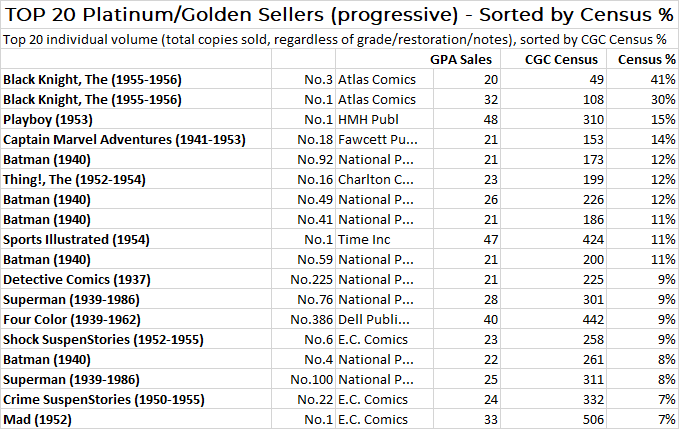
Excluding the issues which reflect individual page sales, the Top 20 Platinum/Golden Seller sorted by Census % indicates the significant percentage of the CGC Census changing hands for Black Knight, followed by a 15% calculation for Playboy #1 (1953). Unlike comic books, CGC began grading issues of Playboy magazine in 2009, and the 15% calculation for the prior twelve months is not comparable to one-twentieth of the CGC Census (as it would be for a comic book). Instead, approximately 8% of all CGC graded copies of Playboy #1 were graded in the prior twelve months, so the 15% of the whole CGC Census recorded as GPA sales is approximately twice as many copies as the CGC Census increase. Sports Illustrated #1 (1954) is comparable with a CGC Census % of 11% over the same period of time.
Because the volumes (number of sales) for each individual comic (and some non-comics) determines the Top 20 lists in the GPA Individual Comic Volumes reports, the number of sales are not comparable across the eras. The top volume for Modern is 2,741 sales in the prior twelve months, while the top volume for Silver is 481, and these are not a “fair comparison” due to the numbers of copies that exist for these books. However, the CGC Census % (calculated percentage of the CGC Census which is represented by GPA sales volume) is comparable across the eras.
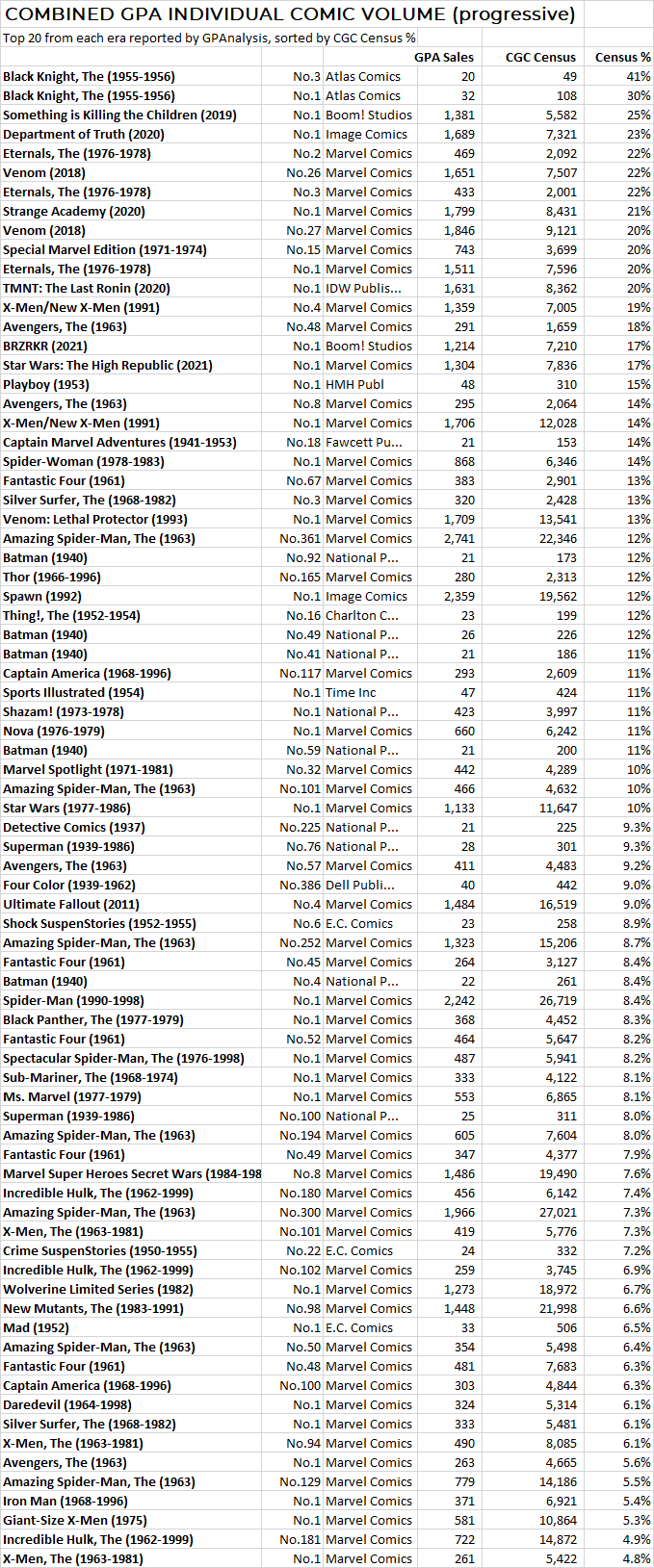
When combined and sorted by CGC Census %, the Top 20 lists by era reflect the market activity which is driven by cinematic and streaming influences, as well as the activity associated with recently-printed popular issues. Individual comics which may be more than 60 years and thousands of recent sales apart now sit side-by-side when viewed by the percentage of the CGC Census which sold in the prior twelve months. As an example of this surprising result, it’s not often that analysis of the comic book market and the CGC Census places Avengers #57, Four Color #386, Ultimate Fallout #4, and Shock SuspenStories #6 in sequence, but when it comes to the percentage of the CGC Census which sold in the prior twelve months recorded at GPAnalysis, they’re all between 8.9% and 9.2%. That’s completely unexpected from this author’s point of view, and the kind of insight that really makes these analyses worth the effort
About the Author
 |
Greg Holland has collected comic books for over 30 years and has been the administrator of the CGC Census Analysis website since 2003, currently located at CGCdata.com. He is the 1999 founder of the ValiantComics.com website and the 2004 ValiantFans.com message board. Dr. Holland holds a Ph.D. in information quality from the University of Arkansas at Little Rock and has held data science positions as research director, analyst, and administrator for government, corporations, and university. Active on the CGC Forums as ‘valiantman’ since 2002, he is also a 15+ year advisor to the Overstreet Comic Book Price Guide and contributor to later editions of the Standard Catalog of Comic Books. Greg resides in Arkansas, USA, with his wife and their daughter. |
Related news
24 Oct 2022
Canadian Price Variants (CPVs) and GPAnalysis.com Recorded Sales
With Canadian Price Variants recorded in GPAnalysis.com for decades, what can the data tell us about rarity and value when comparing against direct editions?
Read more26 May 2022
CGC Census - A Game for the Thousandth Collector
Imagine a game where 1,000 lucky comic collectors are awarded the best available copies of comic books from the CGC Census. Where would ticket #1,000 be for the earliest appearances of favorite characters? Some winning books may surprise you.
Read more